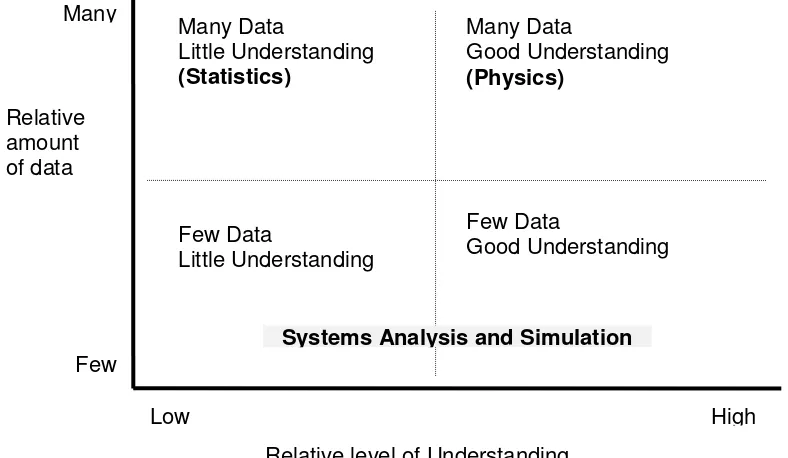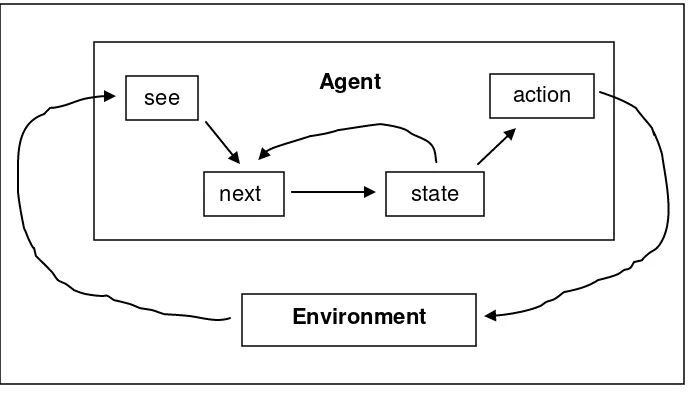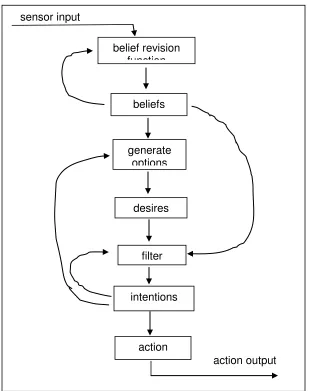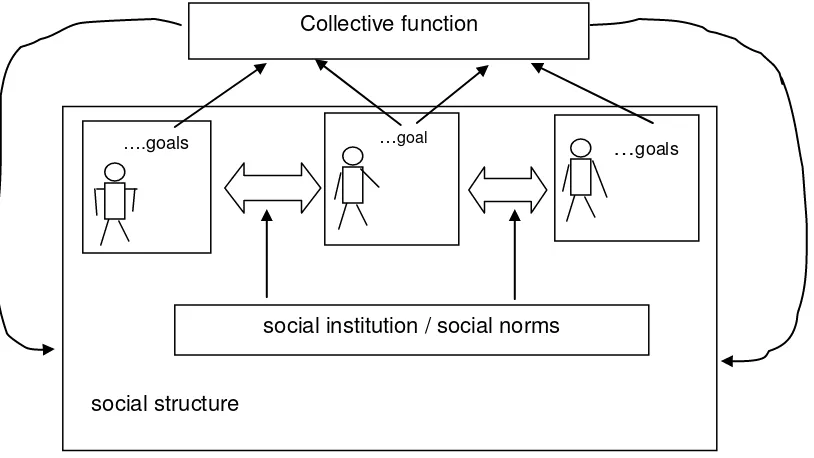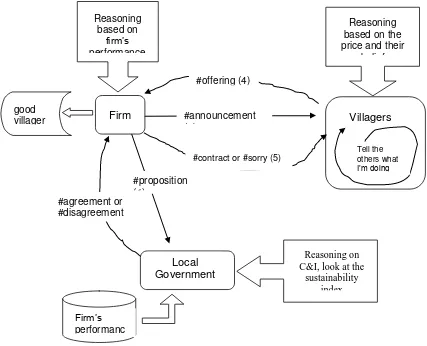USING A MULTIAGENT SYSTEM
FOR SIMULATING FOREST STAKEHOLDERS’ ACTIVITIES1
Herry Purnomo
Laboratory of Forest Biometrics, Faculty of Forestry, IPB
Abstract
This paper is aimed to show the potential use of multiagent system or distributed artificial intelligence for simulating complex ecosystems, which comprise people and natural resources. A multiagent system combines the concepts of system dynamics, GIS modeling and behavior sciences. CORMAS is free software, and the Smalltalk codes are open for everyone. Export/Import and Communication of CORMAS to other software such as Arc Info, IDRISI or Excel can be made with few efforts. The
paper’s author involves in the network of CORMAS further development
INTRODUCTION
It is no disputes that sustainability involves satisfying present needs without
compromising future options. A forest sustainability concept, in which maintaining or
enhancing biodiversity is a key criterion, requires a good understanding on how forests
influenced by involved people. The behaviors of people or stakeholders including forest
managers, local communities, governments, NGOs etc. influence the sustainability of forests.
Each stakeholder has their own goal, perception, activities and the way to communicate with the
others. Simulation on how they interact and their impact to sustainability is an interesting
research domain.
Simulation is a technique particularly deals with dynamic behavior of a system. There
are many ways to predict systems behavior besides simulation such as statistical or physical
methods. Grant et al. (1997) described them in Figure 1. Considering the complexity of
sustainability problems and the amount of data can be taken, simulation is the appropriate way to
deal with time constraints.
Most simulation techniques such as Dynamo, Stella, Powersim, AME (Agricultural
Modeling Environment) etc. were created based on differential or difference equations and
dedicated for system dynamics modeling. This modeling comprises auxiliary variables, states,
Figure 1. Comparisons of Methods of Problem Solving (Grant et al. 1997)
MULTIAGENT SYSTEMS
Simulation of the stakeholders’ activities and interactions needs a tool that is able to represent individual knowledge, belief and behaviour of each stakeholder. First attempt of this
kind of modelling is to assume that each stakeholder or agent who acts autonomously depending
on one’s perception on the environment as shown in Figure 2
Figure 2. Perception and action subsystems (Weiss, 1999)
see action
Environment Agent
Low High
Few Many Few Data Little Understanding Few Data Good Understanding Many Data Little Understanding (Statistics) Many Data Good Understanding (Physics)
Systems Analysis and Simulation
Relative level of Understanding Relative
If the agent want to take into account the previous perception state then the agent needs to
integrate what he perceive and what is already in his mind as depicted in Figure 2. More
comprehensive architectures, called Belief-Desire-Intention (BDI) is shown in Figure 3. These
architectures have their roots in the philosophical tradition of understanding practical reasoning
– the process of deciding, moment by moment, which action to perform in achieving the goal.
Figure 3. Agents that maintain state (Weiss, 1999)
The process of practical reasoning in a BDI agent can be illustrated as follows (Weiss,
1999)
a set of current beliefs, representing information the agent has about its current environment; a belief revision function (brf) which takes a perceptual input and the agent’s current belief,
and on the basis of these, determines a new set of beliefs;
an option generating function, (options), which determines the options available to the agent (its desires), on the basis of its current beliefs about its environment and its current
intentions;
a set of current options, representing possible courses of actions available to the agent; a filter function (filter), which represents the agent’s deliberation process, and which
determines the agent’s intentions on the basis of its current beliefs, desires, and intentions. see
next state
action
a set of current intentions, representing the agent’s current focus – those states of affairs that it has committed to trying to bring about;
an action selection function (execute), which determines an action to perform on the basis of current intentions.
Figure 3. Schematic diagram of a generic belief-desire-intentions architecture (Weiss, 1999)
Agents operate and exist in some environment. The environment might be open or
closed, and it might or might not contain other agents. If it contain other agents, it can be seen belief revision
function
beliefs
generate options
desires
filter
intentions
action sensor input
as society of agents or Multiagent Systems (MAS). Ossowski (1999) illustrated the coordination
among agents as shown in Figure 4.
Figure 4. Coordination among agents (Ossowski, 1999)
The communication protocols enable agents to exchange and understand messages. A
communication protocol might specify that the following messages can be exchanged between
two agents (Weiss, 1999): Propose a course of action Accepts a course of action Reject a course of action Retract a course of action
Disagree with a proposed course of action Counterpropose a course of action
An Artificial Society of Forest Stakeholders
….goals …goal …
goals
social institution / social norms Collective function
A Multiagent System (MAS) is used to simulate the behavior of each agent and the
interaction between agents. The agents located in a spatial system environment. In Figure 5, for
example, there are three kinds of agents used in the simulation i.e. firm, villagers and local government. The firm and villagers are located in a forest in which the local government has an
obligation to maintain its sustainability by giving rules to the firm and local people. As shown
in Figure 6, the firm is located in certain area and they log wood with taking into account the
distance of logging site and wood available. The villagers move to the best site for collecting
NTFP (Non Timber Forest Product).
Figure 5. The example of model components and their interaction located in the spatial system
Figure 6. Spatial representation of the firm’s activity and
villager’s moving activity Government
Villager
Firm
allocated to the firm allocated to th villagers
The communication among stakeholders arranged to meet the actual condition in the field
with some simplifications. An example on the communication is shown in Figure 7. The firm
send a message (#proposition) to the local government that they need wood, more that they can
get from the current logging area. Then, the government reasons this message and then gives
#agreement or #disagreement message. Since the sites are not allocated to the firm but the
villagers, the firm send a message (#demanding) to the villagers asking whether they want to sell
wood to the firm. The villagers reason this message, then perhaps some of them send #offering
message to the firm. Then the firm finds the best offering and makes contract with them. The
villagers who have the contract do not move to collect NTFP, and tell the other villagers as well
as the government that we’re busy. The firm memorise the performance of each villager for future utilisation.
Figure 7. The example of communication of forest stakeholders
Firm Villagers
Local Government #proposition (1) #announcement (3) #agreement or #disagreement Reasoning based on the price and their
belief
#offering (4)
#contract or #sorry (5) Tell the others what
I’m doing
Reasoning on C&I, look at the
Based on the activities of the forest stakeholders, the following can be observed during
the simulation time:
Biodiversity at the landscape level Forest-dependent people well-being Firm’s revenue
Taxes collected by the government
The artificial society was developed with Smalltalk Computer Language in CORMAS
(Common Pool Resources and Multiagent Systems developed by CIRAD Fôret, France.)
environment. The system can be run in Windows, UNIX / LINUX and Macintosh system. The
Initial Condition
Land ownership Randomly distribution of forest condition (status, dark green
better than light green or yellow)
Firm
Local communities
Communication and negotiation
Local Government
Firm
Simulation Process and Outputs
Communication and Negotiation exploitetByTheFirm
SiteOfferedByVillager
aVillagerWorkingForTheFirm
REFERENCES
Becker, B. 1997. Sustainability Assessment: A Review of Values, Concepts, and Methodological Approaches. Issue in Agriculture 10. Consultative Group on International Agricultural Research. Washington, D.C.
Clayton, M. H and N. J. Radcliffe. 1996. Sustainabilitry: A Systems Approach. Eartscan Publication Ltd. London.
Dale, V. H. et al. Landscape Characterization and Biodiversity Research. In: T. J. B. Boyle and B. Boontawee (ed). 1995. Measuring and Monitoring Biodiversity in Tropical and Temperate Forests. CIFOR and IUFRO. Bogor. Indonesia. pp. 47 - 65.
Grant, J. W., E. K. Pedersen and S. L. Marin. 1997. Ecology and Natural Resource Management: System Analysis and Simulation. Addison-Wesley Publishing Company. Reading, Massachusetts.
Guerrin, F. 1991. Qualitative Reasoning about an Ecological Process: Interpretation in Hydroecology. Ecological Model. Elseiver Science Publishers B. V., Amsterdam. pp. 165-201.
ITTO, 1998. Criteria and Indicators for Sustainable Management of Natural Tropical Forests.. ITTO-Policy Development Series No. 7. Yokohama. Japan.
Kerney R. A., G. Bradley, R. Kaplan and S. Kaplan. Stakeholder Perspectives on Appropriate Forest management in the Pacific Northwest. Forest Science. Vol. 45 No. 1. February 1999. Society of American Foresters. pp. 62 – 73.
Milne, B. T. Lessons from Applying Fractal Models to Landscape Pattern. In: Turner, G.T. and R.H. Gardner. 1991. Quantitative Methods in Landscape Ecology. Springer-Verlag, New York. pp. 198-235.
Ossowski, S. 1999. Co-ordination in Artificial Agent Societies: Social Structure and Its Implications for Autonomous Problem-Solving Agents. Springer. Berlin.
Picus, Matti and Kalman Peleg. Optimal Adaptive Classification of Agricultural Produce. Computers and Electronics in Agriculture. Vol. 22. No. 1. February 1999. Elseiver. pp. 11 – 27.
Schmoldt. D. L. . Knowledge Acquisition Using Linguistic-Based Knowledge Analysis. A I Applications: Natural Resources, Agriculture and Environmental Science. Vol. 12 No. 1-3. 1998. pp 1 - 20.
